Thinking about raising capital or selling your SaaS company? Your legal readiness can make or break the deal.
In episode #326, Ben Murray breaks down what investors and acquirers look for during due diligence — and why preparing your cap table, contracts, IP, and financial systems at least six months in advance is essential to protect your company's valuation and ensure a smooth process.
What You’ll Learn
Cap Table Management: Why tracking every issued share, option, and agreement matters — and how to avoid “email equity surprises.”
IP Protection: The critical role of signed IP assignment agreements for employees, contractors, and vendors.
Customer & Vendor Contracts: Why detailed MSAs, renewal clauses, and change-of-control provisions are required for investor confidence.
Accounting Readiness: How clean, timely accounting — especially a complete MRR schedule (revenue by customer by month) — helps prove the health of your recurring revenue and ARR growth.
Sales Tax Compliance: Why sales tax exposure can derail your exit process.
Due Diligence Prep: How to build your data room, organize key documents, and present your SaaS business model with clarity.
Why It Matters
For Founders: Legal gaps can reduce your valuation multiple and slow down the exit timeline.
For CFOs: Solid financial systems and clean documentation protect your cash flow and reputation with investors.
For Investors: A well-prepared company signals operational maturity and reduces transaction risk.
For Operators: Legal readiness supports strategic growth and prevents “deal fatigue” during M&A or fundraising.
Resources Mentioned
Ben’s Blog Post: “SaaS Legal Readiness Checklist” : https://www.thesaascfo.com/why-legal-readiness-can-make-or-break-your-saas-exit/
SaaS Metrics Foundation Course – Learn how to align your financial reporting and recurring revenue metrics for due diligence success.
Upcoming Webinar: “Legal Readiness for SaaS Founders — How to Prepare for an Exit or Raise” (details via newsletter)
💬 Quote from Ben
“You can’t fix legal readiness in a week. Start six months early, or you’ll be scrambling during due diligence when investors start asking for data you don’t have.”
 5 分
5 分 7 分
7 分 2025/11/184 分
2025/11/184 分 5 分
5 分 4 分
4 分 2025/11/115 分
2025/11/115 分 5 分
5 分 2025/11/043 分
2025/11/043 分

